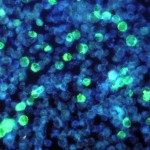Link to Pubmed [PMID] – 29486229
J. Allergy Clin. Immunol. 2018 Feb;
BACKGROUND: Group 2 innate lymphoid cells (ILC2s) are major producers of cytokines driving allergic asthma and elevated numbers of ILC2s have been detected in blood and sputum of asthma patients. Asthma susceptibility has a strong genetic component, but the underlying mechanisms and whether asthma genetics impact ILC2 biology remains unclear.
OBJECTIVE: To study the ILC2 transcriptome and epigenome during airway inflammation (AI) in order to couple these to genes and genetic variants associated with asthma pathogenesis.
METHODS: Mice harboring a reporter for the key ILC2 transcription factor GATA3 were subjected to IL-33-driven AI and ILC2s were isolated from bronchoalveolar lavage fluid and mediastinal lymph nodes. Human ILC2s were purified from peripheral blood and activated in vitro. We employed RNA-Seq, genome-wide identification of histone-3 lysine-4 dimethylation (H3K4me2) marked chromatin and computational approaches to study the ILC2 transcriptome and epigenome.
RESULTS: Activated ILC2s in mice displayed a tissue-specific gene expression signature that emerged from remarkably similar epigenomes. We identified superenhancers implicated in controlling ILC2 identity and asthma-associated genes. Over 300 asthma-associated genetic polymorphisms identified in genome-wide association studies localized to H3K4Me2gene regulatory elements in ILC2s. A refined set of candidate causal asthma-associated variants was uniquely enriched in ILC2 – but not Th2 cell – regulatory regions.
CONCLUSIONS: ILC2s in AI employ a flexible epigenome that couples adaptation to new microenvironments with functional plasticity. Importantly, we reveal strong correlations between gene regulatory mechanisms in ILC2s and the genetic basis of asthma, supporting a pathogenic role for ILC2s in allergic asthma.

